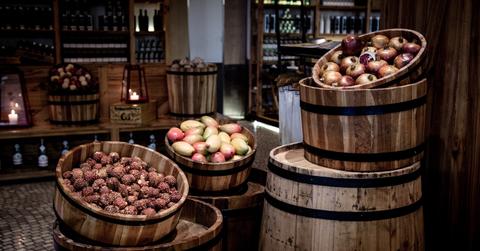Eco-Friendly Barrel Reduces Oak And Preserves Flavor
One company has set out to make traditional oak barrels more sustainable and efficient. With an unusual square design, this new barrel helps keep all the benefits of a traditional barrel while using less wood.
Updated May 25 2019, 5:23 a.m. ET
Oak barrels have been used for hundreds of years to make our favorites spirits. But is the traditional design as sustainable as it can be? For context, one oak tree can produce about two to five oak barrels. Essentially, large scale beer and wine require a small forest of oak trees at all times to keep their cellars full. Since those barrels have a limited life span, older brewers, and vintners need to cut down hundreds of oak trees over time. Consequently, there is always a demand for barrels. The main issue is that only 30 percent of traditional oak barrels is used to create the flavor. The rest of the wood is used in the barrel’s outer structure, which is essentially a waste.
Russ Karasch saw this problem and decided to upgrade the vintage design. As a result, he created Squarrel, a sustainable square shaped barrel that is both reusable and customizable. Karasch created a stainless steel frame to give the barrel support. Once made, the frame can be used over and over again.
More importantly, the new design uses one third of the wood required by a traditional barrel. Unlike the old design, all the wood in a Squarrel is used to create flavor for spirits, beer, or wine. By minimizing wood in the frame, Karasch was also able to maximize the usage of space since the square barrel design allows for easy stacking. Squarrel is also planning on creating a program where it will plant a tree for every barrel purchased.
So, how does it work? Each barrel comes with 12 staves that are separately inserted into the frame. The wood allows the spirits to mature like a traditional barrel. Once someone has the frame, the replacement staves do not require nearly as much space for shipping purposes. While traditional barrels normally need pallets, staves only need about the space of a shoebox. The end result is less CO2 emissions from shipments.
Apart from using less wood, each barrel can be totally customized because the staves can be mixed and matched. This facilitates flavor experimentation through different wood types, toast levels and so on. Karasch remarked on this feature, "Now you can have American oak, French oak, Hungarian oak, Mongolian oak, toast levels one through four, and you've got 12 staves, so you can do 12 different flavors in your barrel, which nobody else can do."
The efficiency of the barrel is attractive because the cross-cut wood staves can age the spirits 8 times faster than traditional methods. The barrel also doubles as a keg. Users can carbonate in the barrel and use it in tap lines. With this one design craft distillers, brewers, and vintners can not only create their product sustainably, but also offer new unique flavors.
